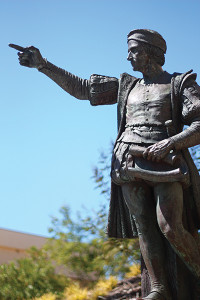I’m not sure what Christopher Columbus was doing on our university campus. Maybe he had taken up residence on the commons because we were a Christian university and he was a Christian explorer, whose voyage to the “New” world had been funded with the property confiscated from European Jews during the Christian Inquisition. Maybe it was because he represented the “manifest” destiny of the Americas; God’s plan to give an entire continent as a Promised Land to Christian settlers (how Indigenous peoples figure into this supposed plan, other than as obstacles to the will of God, has never been explained to me).
For whatever reason, Columbus was allowed onto the school grounds, where he struck an authoritative pose there on his pedestal, pointing a commanding, bronze finger out towards the Pacific Ocean as if to direct manifest destiny even further west. Perhaps towards another ocean; another people to conquer.
I think he was welcome in our midst because we as descendants of Christian European settlers have yet to look critically at our heritage. We have not yet owned up to the brutality of massacres, rapes, and trails of tears that litter our history. Did you know that before he was elected president, Andrew Jackson and his men cut strips of flesh from the bodies of murdered Muscogee Indians, including women and children, and tanned them into human leather to make bridle straps for their horses? It’s the sort of blood-curdling violence we associate with sociopaths, but in this case the perpetrators were men who later returned home to their communities afterward as respected fathers, husbands, and members of local churches. The perpetrators were the U.S. army. This was typical of the genocide perpetrated against indigenous peoples across North America from 1492 onward.
Our ignorance of the past prevents us from understanding the ways that colonization continues unabated in the twenty-first century. For instance, did you know that in Canada, hundreds of thousands of First Nations children were forcibly taken away from their families and communities to attend mandatory, church-run residential schools designed to assimilate them into white culture? The last of these schools did not close until 1996. Or did you know that to this day, there is no law enforcement agency in the United States authorized to prosecute a non-Native person for rape, homicide, or any other crime committed on a Native American reservation?
Here we are, 523 years after Columbus sailed the ocean blue, still celebrating the colonizing oppressor and sweeping the colonized oppressed under the rug, as if they are not still here. As if they were never here.
Why do we do this?
Perhaps, our society celebrates in Columbus the idealized version of our own history that we want to believe. Perhaps the evil he perpetrated and continues to represent is the same shadow side we are unwilling to acknowledge in ourselves as a society to this day.
Now that I think about it, maybe the statue of Columbus on Pepperdine’s campus should stay exactly where it is. Not as a monument to any kind of discovery or heroism, but as a ghost from our own past to serve as a reminder of the incalculable evil that is possible when we refuse to acknowledge the personhood of those who are not like us, and when we take God’s name in vain, pasting it onto our own campaigns of self-interest and self-aggrandizement.
